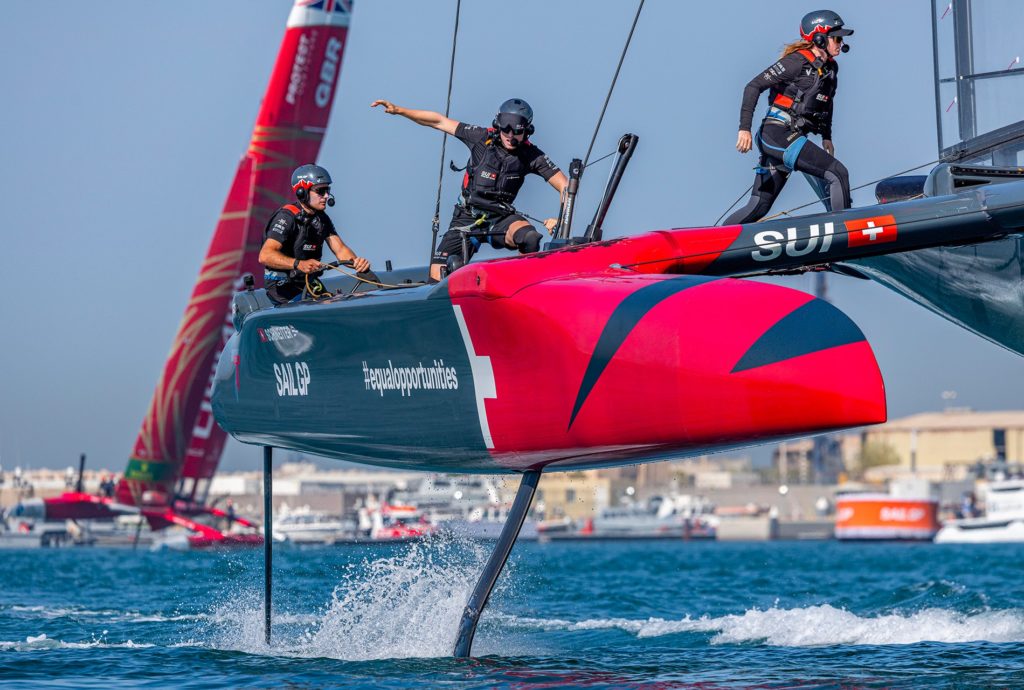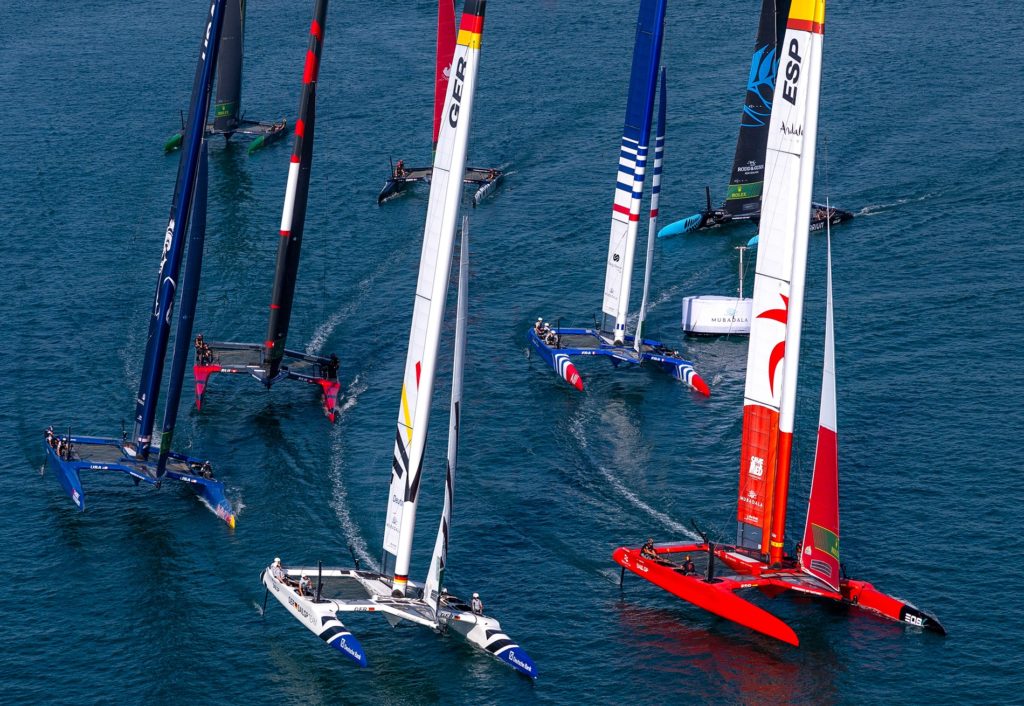Text: Pierre-Antoine Preti
In the United Arab Emirates, the Swiss team failed to achieve its goal of finishing in the top half of the standings. The result: seventh place in Dubai and last place in Abu Dhabi, following a deluge of penalties. The Swiss team is growing up in the face of world-class competition.
“Sébastien Schneiter still lacks confidence, but he’s a good helmsman.
At the Abu Dhabi Grand Prix on January 13, Russell Coutts’ analysis was both fair and trenchant. “The key moment for a young sportsman is to win his first event and then go on to win a second. Before that, Sébastien will still be apprehensive about facing stars like Tom Slingsby or Peter Burling. We need to continue working in depth. The illustrious organizer’s considerations are not devoid of affection. What’s missing, however, is the realization of the prophecy, which is sorely overdue for the Swiss team. After a disappointing Mediterranean (see our previous edition), theEiger experienced a desert crossing in the United Arab Emirates.

In a very lightly winded Abu Dhabi Grand Prix, the teams sailed in fours, in archimedean mode, with the wing fully extended and the foils in light airs. Unfortunately, this lakeside atmosphere did not benefit the Swiss. To make matters worse, the weekend started with a 4-point penalty following contact with the English during the training session. On Saturday, Team Tilt suffered several penalties. Eight over the whole weekend. This deluge of faults resulted in a four-point drop in the overall season ranking, with the Swiss in last place.
In the third race, Sébastien Schneiter changed his strategy. He started in the middle of the line, with fresh wind, and passed the first marker in fourth position. A position he protected right up to the finish line. It proved to be the best race of the weekend. On Sunday, a ninth and tenth place finish prevented the Swiss from competing in the final, won by Peter Burling (NZL) ahead of the Spaniards and Americans.
It’s all there for the taking
At the Swiss stand, however, everything is there to do the job properly. Trainer Mickael Vincent is warming up the bodies and awakening the minds: “We’re working above all on the sensory and cognitive aspects of the team.” Sailors need to be prepared to make quick, agile and reflexive decisions. Coach Tanguy Cariou takes a cautious look at the first half of the second season: “For the moment, it’s hard to think in terms of results. We need to speed up our progress. The starts are improving, but we still need to work on the rest of the course.” Alex Schneiter, the project’s promoter, backs up the coach’s analysis: “Team Tilt is not yet where we wanted it to be at the start of the season, i.e. regularly in the top five.”


Two select advisors
The objective is an ambitious one. The team has therefore enlisted the help of two choice advisors: Australian Glenn Ashby and New Zealander Nathan Outteridge, who will supervise the Swiss team. The latter is none other than the second helmsman of the New Zealand Defender in the America’s Cup. When asked for his view of the Swiss team, he remains optimistic: “The Swiss program is building nicely. The results will come.”
But the wait is long and painful. It seems to be weighing more and more heavily on the shoulders of the helmsman, Sébastien Schneiter. One of the country’s top flying boat pilots, he belongs to a generation of sailors who have honed their skills on foiling moths and Olympic skiffs on Lake Geneva.
Third in the Youth America’s Cup in 2017, thirteenth at the Rio Olympics in 2016, “Seba” already has an impressive CV. Last summer, on the 49er he shares with Arno de Planta, he won the vice-world champion title and also the first Swiss ticket to the Paris Olympics, across all sports.
An impressive level
Is being one of Switzerland’s top sailors enough to challenge the world’s top sailors? To find out, you had to see the individuality of the line-up at the opening press conference in Abu Dhabi on January 12. It was in the sumptuous setting of Jean Nouvel’s Louvre that the level of the Abu Dhabi Grand Prix skippers could be measured: Tom Slingsby (AUS), Peter Burling (NZL), Phil Robertson (CAN), Taylor
Canfield (USA) and Quentin Delapierre (FRA), to name but a few, are the best sea stars of the moment. And that’s not counting Sir Ben Ainslie’s reward wagon, which has just been replaced by double Olympic champion Giles Scott. Olympic gold medals shine on almost every chest.
Sébastien Schneiter takes a lucid look at his team’s sporting objectives: “Of course we’re dreaming of victories, but we have to be realistic. We don’t have the capacity at the moment. Our long-term goal is to train six young Swiss sailors in one of the most hotly contested series in the world. We want to last over time.

Alinghi Red Bull Racing mercenary at Team Tilt
Around the helmsman, a young and experienced team sets off around the world every year. Twelve legs this year. Fifteen next year. That’s what strategists Laurane Mettraux and Maud Jayet, wing trimmer Will Ryan, and grinders Julien Rolaz, Jeremy Bachelin and Eliot Merceron have in mind. The core team was joined by a strange mercenary. For the first time, Alinghi Red Bull Racing (ARBR) has accepted the idea of a crew exchange. Nicolas Rolaz will race the second half of the season on the Swiss F50.
It has to be said that for the other teams involved in both circuits, exchanges between the America’s Cup and SailGP have become the norm: Cup sailors are sorely lacking in regattas. And SailGP has another attractive argument: in the paddocks, people talk about the effect caused on the world’s best sailors by the league’s substantial prize moneys: $400,000 per Grand Prix (including $200,000 for the winner) and $2 million for the season’s victory. These staggering sums directly benefit the sailors, as required by the regulations. So make no mistake. While a Team Tilt victory may not be on the cards for the time being, a blossoming is probably underway. TheEiger has chosen to tackle world sailing from the north face.

